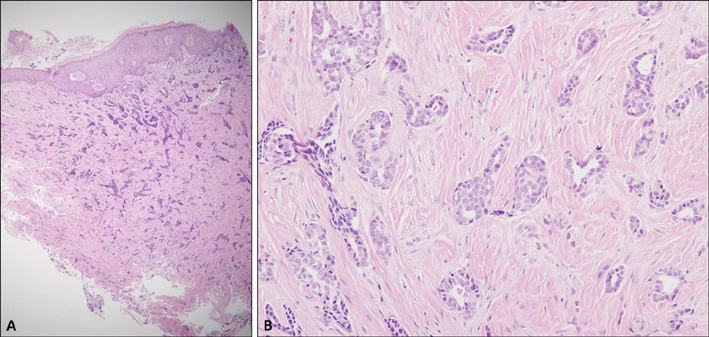Ann Dermatol.
2017 Dec;29(6):786-789. 10.5021/ad.2017.29.6.786.
Syringoid Eccrine Carcinoma of the Thigh
- Affiliations
-
- 1Department of Dermatology, Kyung Hee University Hospital at Gangdong, Kyung Hee University School of Medicine, Seoul, Korea. bellotte@hanmail.net
- KMID: 2395190
- DOI: http://doi.org/10.5021/ad.2017.29.6.786
Abstract
- Syringoid eccrine carcinoma (SEC) is a rare cutaneous malignant tumor thought to be derived from eccrine sweat apparatus. It is usually present in the head, neck and trunk region, and often occurs in the fourth to seventh decades of life. A 94-year-old male patient visited our department with an 80-year history of a lesion showing a 2×2 cm sized well-demarcated round shaped erythematous to pinkish colored nodule with ulcer on his left thigh. Histological findings revealed a tumor consisted mainly of numerous small cords and nests forming luminal or tubular structures and tumor cells showing variable atypia. Some ductal structures showed tadpole appearance. On immunohistochemical staining, epithelial membrane antigen, S-100, cytokeratin 7 and carcinoembryonic antigen were reactive and Ki-67 showed less than 10% positivity. Based on these findings, the final diagnosis was made as SEC. The patient was treated with local wide excision and didn't show any recurrence during the follow-up period of 12 months. Herein, we report a very rare case of SEC which occurred on the left thigh and discuss 10 cases of SEC presented on the extremities, including our case.
MeSH Terms
Figure
Reference
-
1. Stewart CL, Novoa RA, Seykora JT. Tumors of the epidermal appendages. In : Elder DE, Elenitsas R, Murphy GF, Rubin AI, Xu X, editors. Lever's histopathology of skin. 11th ed. Philadelphia: Wolters Kluwer;2015. p. 1092.2. Freeman RG, Winkelmann RK. Basal cell tumor with eccrine differentiation (eccrine epithelioma). Arch Dermatol. 1969; 100:234–242.
Article3. Sidiropoulos M, Sade S, Al-Habeeb A, Ghazarian D. Syringoid eccrine carcinoma: a clinicopathological and immunohistochemical study of four cases. J Clin Pathol. 2011; 64:788–792.
Article4. Nishizawa A, Nakanishi Y, Sasajima Y, Yamazaki N, Yamamoto A. Syringoid eccrine carcinoma with apparently aggressive transformation: case report and review of the literature. Int J Dermatol. 2006; 45:1218–1221.
Article5. Evans AT, Parham DM, Van Niekerk LJ. Metastasising eccrine syringomatous carcinoma. Histopathology. 1995; 26:185–187.
Article6. Malmusi M, Collina G. Syringoid eccrine carcinoma: a case report. Am J Dermatopathol. 1997; 19:533–535.7. Serrano G, Aliaga A, Bonillo J, Pelufo C, Otero D. Basal cell tumor with eccrine differentiation (eccrine epithelioma). J Cutan Pathol. 1984; 11:553–557.
Article8. Sequeira J, Wright S, Baker H. Basal cell tumour with eccrine differentiation (eccrine epithelioma)--a histochemical and immunocytochemical analysis of a case. Clin Exp Dermatol. 1987; 12:58–60.
Article9. Grady JF, Boumendjel Y, Tahniyath MS. Subungual syringoid eccrine carcinoma of the great toe nail complex: a case report. J Am Podiatr Med Assoc. 2014; 104:504–507.10. Mehregan AH, Hashimoto K, Rahbari H. Eccrine adenocarcinoma. A clinicopathologic study of 35 cases. Arch Dermatol. 1983; 119:104–114.
Article11. Tulenko JF, Conway H. An analysis of sweat gland tumors. Surg Gynecol Obstet. 1965; 121:343–348.12. Moy RL, Rivkin JE, Lee H, Brooks WS, Zitelli JA. Syringoid eccrine carcinoma. J Am Acad Dermatol. 1991; 24:857–860.
Article13. Shah MM, Steele EA, White KP, Wilson DJ. Syringoid eccrine carcinoma of the eyelid presenting as cicatricial entropion. Int J Ophthalmol. 2014; 7:912–913.14. Ballardini P, Margutti G, Pedriali M, Querzoli P. Metastatic syringoid eccrine carcinoma of the nipple. Int Med Case Rep J. 2012; 5:45–48.
Article15. Abedi SM, Yu R, Salama S, Alowami S. Syringoid eccrine carcinoma. Cutis. 2015; 96:162.




